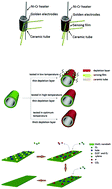Xylene sensor based on α-MoO3 nanobelts with fast response and low operating temperature
Abstract
A hydrothermal treatment strategy was used to synthesize α-MoO3 nanobelts. X-ray diffraction (XRD) and scanning electron microscopy (SEM) was used to characterize the phase and the morphology of the samples, respectively. The results show the length and the width of the α-MoO3 nanobelts were about 6 μm and 200 nm, respectively. The sensing properties towards various types of gases were tested and heater-type sensors coated with α-MoO3 nanobelts showed excellent performance towards xylene. The sensors achieved a response of 3 to 100 ppm xylene at an operating temperature of 206 °C. The response and recovery time were 7 s and 87 s, respectively.


 Please wait while we load your content...
Please wait while we load your content...